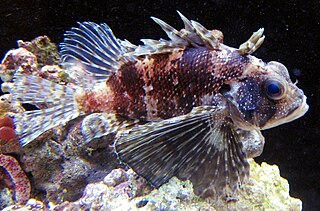
Marine hatchetfishes or deep-sea hatchetfishes are small deep-sea mesopelagic ray-finned fish of the stomiiform subfamily Sternoptychinae. They should not be confused with the freshwater hatchetfishes, which are not particularly closely related Teleostei in the characiform family Gasteropelecidae.

The marine hatchetfishes or deep-sea hatchetfishes as well as the related bottlelights, pearlsides and constellationfishes are small deep-sea ray-finned fish of the stomiiform family Sternoptychidae. They are not closely related to and should not be confused with the freshwater hatchetfishes, which are teleosts in the characiform family Gasteropelecidae. The Sternoptychidae have 10 genera and about 70 species altogether.

Ridgeheads, also known as bigscales, are a family of small, deep-sea stephanoberyciform fish. The family contains approximately 37 species in five genera; their distribution is worldwide, but ridgeheads are absent from the Arctic Ocean and Mediterranean Sea. Although the family is one of the most widespread and plentiful of deep-sea families, none of its members are of interest to commercial fishery.

The French angelfish is a species of marine ray-finned fish, a marine angelfish belonging to the family Pomacanthidae. It occurs in the Western Atlantic Ocean.

The gray angelfish, also written as grey angelfish and known in Jamaica as the pot cover, is a species of marine ray-finned fish belonging to the marine angelfish family, Pomacanthidae. It is found in the Western Atlantic Ocean.

Caesionidae, the fusiliers, are a family of marine ray-finned fishes in the order Perciformes. The family includes about 23 species. They are related to the snappers, but adapted for feeding on plankton, rather than on larger prey. They are found at reefs in the Indo-Pacific and in the Red Sea.

Walter Percy Sladen was an English biologist who specialised in starfish.

Genicanthus semifasciatus, the Japanese swallow, is a species of marine ray-finned fish, a marine angelfish, belonging to the family Pomacanthidae. It is found in the Western Pacific.

Cantherhines dumerilii is a species of fish in the family Monacanthidae, the filefishes. Its common names include whitespotted filefish, barred filefish, orange-fin file, and yelloweye leatherjacket. It is distributed in the Indian and Pacific Oceans where it is found on coral reefs.

The longnose hawkfish is a species of marine ray-finned fish, a hawkfish belonging to the family Cirrhitidae. It is found on tropical reefs of the Indian Ocean and the Pacific Ocean, where it can be found at depths around 10 to 100 m. It prefers the steep outer slopes of the reefs amongst gorgonians and black corals. This species can reach 13 cm (5.1 in) in total length. It can also be found in the aquarium trade. It is currently the only known member in its genus.

Dendrochirus barberi, the Hawaiian lionfish or green lionfish, is a species of marine ray-finned fish belonging to the family Scorpaenidae, the scorpionfishes and lionfishes. It occurs in the Eastern Central Pacific. It occasionally makes its way into the aquarium trade.
Vinciguerria poweriae is a species of lightfish belonging to the genus Vinciguerria. They are mostly found in seawater 300–600 metres (1,000–2,000 ft) deep during the day and 50–350 metres (160–1,150 ft) deep at night. They feed on small crustaceans.

Centropyge multispinis, known by the common names bluefin dwarf, brown pygmy angelfish, dusky angelfish, dusky cherub, many-spined angelfish, and multispined angelfish, is a species of marine ray finned fish, a marine angelfish belonging to the family Pomacanthidae. It is found in tropical waters of the Indo-Pacific area.

The black scorpionfish, also known as the European scorpionfish or small-scaled scorpionfish, is a venomous scorpionfish, common in marine subtropical waters. It is widespread in the Eastern Atlantic Ocean from the British Isles to the Azores and Canary Islands, near the coasts of Morocco, in the Mediterranean Sea and the Black Sea.

Small red scorpionfish is a venomous Scorpionfish, common in marine subtropical waters. It is widespread in the Eastern Atlantic from the Bay of Biscay to Senegal, Madeira, Azores and the Canary Islands, including the Mediterranean and the Black Sea.

Pterois sphex, the Hawaiian turkeyfish or Hawaiian lionfish is a species of ray-finned fish with venomous spines belonging to the family Scorpaenidae, the scorpionfishes and lionfishes. It is found in the eastern Central Pacific, specifically in marine waters off of Hawaii. It is found in seaward reefs and lagoons at depths from 3 – 122 m.
The longfin gurnard, the long-finned gurnard or shining gurnard, is a species of ray-finned fish belonging to the family Triglidae, the gurnards and sea robins. This fish is found in the eastern Atlantic Ocean, including the Mediterranean Sea and the Black Sea. This species is of commercial importance as a food fish.

Argyropelecus affinis is a species of ray-finned fish in the family Sternoptychidae, found in the tropical and subtropical Atlantic, Indian and Pacific Oceans. Common names for this fish include Pacific hatchetfish, deepsea hatchetfish and slender hatchetfish. It inhabits the mesopelagic zone and is either non-migratory or performs short daily vertical migrations.

Sternoptyx diaphana, the diaphanous hatchetfish, is a species of deep sea ray-finned fish in the family Sternoptychidae. It is the type species of the genus Sternoptyx, and was first described by the French naturalist Johann Hermann in Der Naturforscher 1781.

Hemitaurichthys thompsoni, Thompson's butterflyfish, is a species of marine ray-finned fish, a butterflyfish belonging to the family Chaetodontidae. It is found in the Pacific Ocean.



















